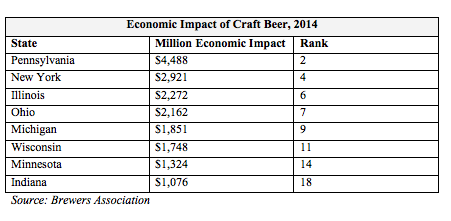By AMELIA HAVANEC
Capital News Service
LANSING – Nineteen breweries in the Northwest corner of Michigan’s Mitten are in pursuit of the perfect pint, according to the Michigan Brewers Guild.
They stretch from Mason to Emmet counties and are just a sampling of beer’s impact throughout the state. With 159 breweries, Michigan ranks sixth in the nation, according to the Brewers Association, an American trade group that promotes craft beer.
And more Michigan beer aficionados are converting their home-brewing hobbies into careers. Dutch Girl Brewery in Ottawa County, a husband-and-wife run craft brewery, recently passed its 90-day anniversary.
But one thing remains as clear as a crisp golden pilsner: The state hasn’t reached a saturation point for all those suds.
Of all beer sold in the state, 6.5 percent is Michigan-brewed, said Scott Graham, executive director of the Michigan Brewers Guild. “That’s going to go past 20 percent” in the next few years.
There’s good money in fancy beer, according to the Brewers Association. Accounting for some breweries’ abilities to stretch distribution across state lines, the U.S. craft beer industry generated $1.85 billion for the state’s economy in 2014, contributing to more than 14,000 full-time jobs and $571 million in wages.
The data reflects two national surveys that looked at the craft beer industry. They examined the economic impact of including craft brewers, craft beer wholesalers and retailers, and suppliers of raw materials like glass, hops and malted barley.
The report defines a craft brewery as independently owned, producing no more than 6 million barrels annually. The majority of a craft brewer’s beer must enhance flavor, rather than lighten it.

“It’s not to say that the major American industrial light lagers aren’t well made — they’re just boring,” Graham said. “People want something more interesting and to know where things are being made, like if it’s local. All that rolls into beer.
“It’s not a fad or cool trend. It signifies a bona fide shift in consumer preference.”
The craft beer impact also has opened doors for a boom in hops-growing, especially in Northwest Michigan.
Money spent on local beer goes right back into the state, especially when those small craft breweries source local ingredients to make their product. Fifty percent of the hops used by Dutch Girl Brewery is Michigan grown and harvested in farms such as Black Creek Hops in Mason County.
Luke Finchem, chief beer officer at Dutch Girl Brewery, said, “The neat thing about brewing beer in Michigan is you can get all Michigan ingredients. I think that’s what endears your community.
“We’re using local resources, whereas Anheuser-Busch is buying train loads of rice or corn from four states away,” Finchem added. “It’s wonderful they’re still spending money inside the U.S., but they’re not helping the guy that might be their neighbor who’s trying to put food on his table or pay his mortgage.”
Beer is made from grain, yeast, water and hops. The cone-shaped hop plants add a bitter flavor and aroma particularly noticeable in India Pale Ales such as the Two Hearted Ale brewed by Bell’s Brewery in Kalamazoo. When demand for craft beer goes up, more interest and money is spent producing the crop.
Michigan has a unique leg-up to capitalize on the hops appeal– its climate.
Northwest Michigan “sits at the 45th parallel, a band ideal for growing hops,” said Jason Warren, chief executive officer of MI Local Hops in Grand Traverse County.
The state’s climate is similar to Oregon and the Yakima Valley in Washington, where the most U.S. hops are grown, he said.
“What Michigan has in its favor right now is water, which is a big issue out West. The price of land is relatively low compared to some of these other growing regions and we have an established farming infrastructure in place, which contributes to the know how of the farmers” to expand from growing grapes, cherries and apples to hops, Warren said.
The Hop Growers of America reports that Michigan harvested 300 acres of hops in 2014, at least double of all other Great Lakes states.
And Warren’s investment group planted 200 additional acres of hops earlier in the year, with 200 more expecting to be planted in 2016 – easily doubling Michigan’s land devoted to hop production.
“From a revenue generation standpoint right now, Michigan’s looking at $3 million a year, but as we double our acreage, you’re going to go from $3 million to $6 million in revenue,” Warren said. When all other business costs are included, “there’s a lot of money going into the economy right now, at least $10 million, to fuel that growth.”
From the 300 acres harvested last year, Warren says about a third of the crop came from farms in Leelanau and Grand Traverse counties because of their proximity to Lake Michigan and well-drained soil.
“It’s interesting that most of the larger brewers are down in the southern part of the state but probably my guess is that the majority of the production of hops is growing in the northern part of the state,” Warren said.
